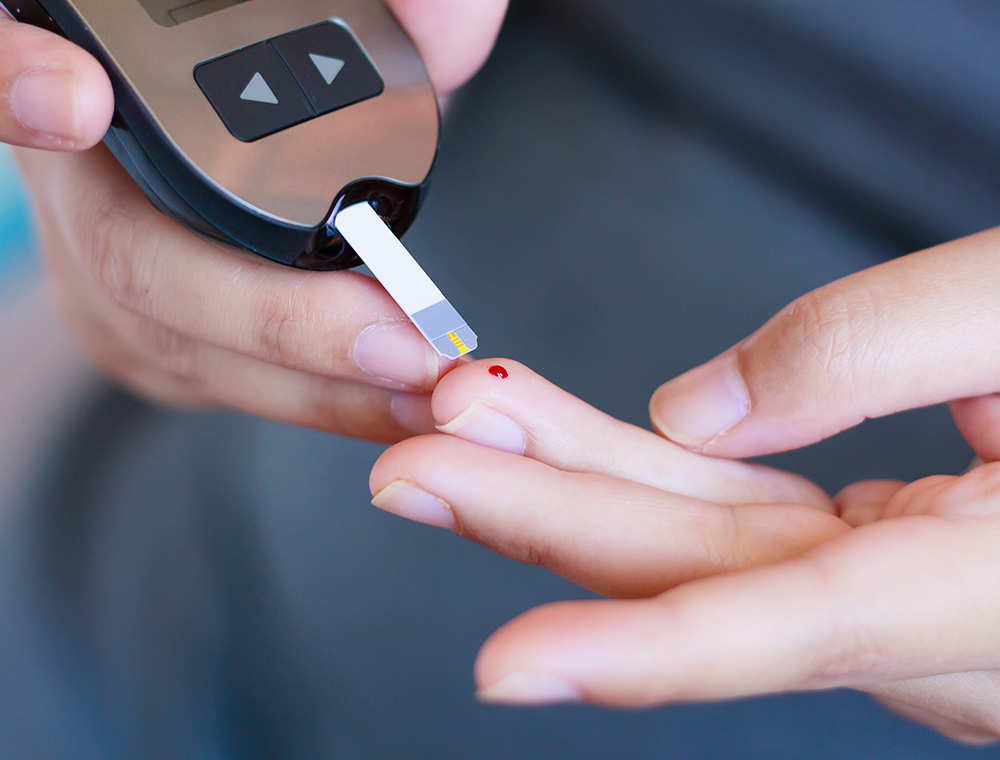Diabetes and Celiac Disease
The estimated prevalence of celiac disease in patients with type 1 diabetes is approximately 6%. Most patients with both conditions have asymptomatic celiac disease, or symptoms that may be confused for symptoms of their diabetes. For this reason, screening for celiac disease is recommended after a diagnosis of type 1 diabetes, as well as counseling for the signs and symptoms of type 1 diabetes after a celiac disease diagnosis.
Type 1 Diabetes
In cases of type 1 diabetes, the immune system attacks and destroys the specialized cells in the pancreas that produce insulin. When the body can no longer produce sufficient insulin (a protein that regulates blood glucose concentration), the resulting chronically high glucose levels in the blood (hyperglycemia) cause blood vessel and nerve damage. This can lead to serious complications, such as: stroke, heart disease, kidney disease, and amputation.

The exact cause that triggers the autoimmune reaction in type 1 diabetes is still not understood. There are genetic and environmental factors that can increase the risk of developing diabetes, as well as certain drugs that lead to the specific destruction of the beta cells. The condition is usually diagnosed in children or young adults, which is why it was once called juvenile diabetes.
Diabetes is much easier to test for than celiac disease. A blood test, usually performed after a period of fasting, measures how much glucose is in the blood. If the glucose level is over a certain threshold, a diabetes or pre-diabetes diagnosis is made.
Symptoms of diabetes include: frequent urination, thirst, hunger, weight loss, dry mouth, and fatigue.
If caught early enough, the autoantibodies (antibodies that attack the body) can be tested before the patient actually has diabetes or pre-diabetes.
Treating diabetes typically involves both a change in diet as well as insulin injections. Patients must monitor and control their blood sugar at all times to avoid hyperglycemia (high blood sugar) as well as hypoglycemia (low blood sugar).
Type 2 Diabetes
Patients with type 2 diabetes still have insulin-producing cells in the pancreas, but they don’t produce enough insulin, or their other cells do not respond to insulin. This lack of responsiveness is called insulin resistance, which results in high blood glucose concentrations similar to type 1 diabetes, and can cause similar symptoms and complications. The causes of type 2 diabetes are less established than for type 1, but there are certain things that can put someone at higher risk:
- Being overweight
- Being inactive
- Having family members with type 2 diabetes
- Being a certain ethnicity, such as: African-American, Asian-American, Hispanic, or Native-American
- Being over age 45
- Developing pre-diabetes or gestational diabetes
- Having polycystic ovary syndrome

Diabetes and Celiac Disease
The link between type 1 diabetes and celiac disease was first established in the 1960s. The estimated prevalence of celiac disease in patients with type 1 diabetes is approximately 6%, and about 1% in the general population. Due to the significantly higher prevalence of celiac disease in diabetes patients, many doctors recommend getting screened for celiac disease after a diagnosis of type 1 diabetes, and vice versa.
There is no established link between type 2 diabetes and celiac disease.
A 2013 study found that there were no standard uniform practices for screening type 1 diabetes patients for celiac disease. Of the facilities in the study that did screen for celiac disease, 60% only did so if there were symptoms present. The authors of the study suggested a uniform screening protocol be in place. Additionally, dietitians should acquire further education on the gluten-free diet for patients with type 1 diabetes and celiac disease.
There is no established link between type 2 diabetes and celiac disease. Type 2 diabetes does have genetic components, but they are not associated with celiac disease genes like type 1 diabetes. It is common for patients with celiac disease to be overweight, with one study showing 40% of patients with celiac disease being overweight at diagnosis and 13% in the obese range, which puts them at a higher risk for type 2 diabetes. The gluten-free diet can often be low in fiber, and many processed gluten-free products have an increased glycemic index with increased fat and less protein compared to gluten containing meals. These are two contributing factors to increased weight gain in celiac disease patients.
Managing Celiac Disease and Diabetes
The gluten-free diet may improve glycemic control for diabetic patients, although that is still controversial, as some studies support the idea and others suggest there is no difference in glycemic control between normal diabetic patients and diabetic patients with celiac disease on a gluten-free diet.
Untreated celiac disease, leading to a damaged small intestine, can increase risk of hypoglycemia because the small intestine may no longer be able to absorb nutrients, such as sugars, properly, making diagnosis even more imperative.
Celiac Disease and Type 1 Diabetes
Many individuals diagnosed with type 1 diabetes only discover they have celiac disease through routine screening because of the known relationship between the two conditions. Most report having no symptoms of celiac disease, and that the diagnosis is sometimes seen as an after-thought to the diabetes.
Whether or not individuals have symptoms, if a celiac disease diagnosis is confirmed, it is absolutely essential to follow a strict gluten-free diet to avoid the same health risks for untreated celiac disease. Perhaps most important is that the earlier a gluten-free diet is initiated, the lower the chances are of developing additional autoimmune disorders.
It can be very difficult to evaluate the effectiveness of a gluten-free diet without obvious symptoms, and equally as difficult to find the motivation to strictly follow it. Follow-up care with your physician is essential in these cases for monitoring blood antibody levels for celiac disease; a follow-up endoscopy may be indicated to confirm that intestinal healing has occurred.
Weight gain or loss, fatigue, neuropathy, and gastrointestinal problems can all be related to either celiac disease or diabetes, so it can be difficult to differentiate between the two without exploring further with your healthcare providers. Consider the following information when managing a dual-diagnosis of celiac disease and diabetes: with practice, you won’t just be managing, you will be thriving!

General Guidelines and Advice
- Work with a knowledgeable and credentialed dietitian (registered dietitian and/or certified diabetes educator). You may get the most personalized advice and successful life changes from working one-on-one with someone you trust.
- Many gluten-free flour substitutes are much higher in carbohydrate content than their gluten-containing counterparts. Gluten-free products may be highly refined and contain added sugars or starches to mimic the mouth-feel and texture of gluten.
- Additional insulin and/or smaller portion sizes may be necessary to counteract these effects when enjoying such products.
- Some gluten-free alternatives are made with very low-carbohydrate substitutes, therefore, standard carbohydrate counts are not appropriate. Administering standard estimations of insulin may result in dangerously low blood glucose levels. Instead, read ingredient labels when possible for carb counts, or count the food as a vegetable that is very low in carbs and correct with insulin at the next meal if your estimation was too low.
- Example: cauliflower “mashed potatoes” or pizza crust
- Example: almond flour cookies or bread
- Always keep gluten-free carbs on-hand for managing blood glucose in instances where gluten-free foods may be difficult to find.
- For the average person with celiac disease, a salad may be a reasonable option at a restaurant that doesn’t have a gluten-free menu. However, for someone with both diabetes and celiac disease, a salad comprised only of vegetables, meat, and dressing is likely too low in carbohydrate to meet standard meal recommendations. Always come prepared with additions, or use a beverage (like a smoothie or a latte) as your source of carbohydrate if necessary.
- Non-perishables like granola bars, protein bars, crackers, meal supplement drinks, and dried soybeans are great to keep in your car, pocket, or purse.
- Advise a manager or authority of your medical needs if you need to eat in an establishment that prohibits outside food and cannot accommodate your gluten-free needs. Keep a doctor’s note on-hand for places like the airport, movie theaters, sporting games, conference centers, and amusement parks.
- Follow general dietary advice for health on a gluten-free diet to maximize the nutritional quality of your carbohydrates. Whole grains and unrefined, unprocessed complex carbohydrates will deliver maximum health benefits while helping you maintain your blood sugar. See more advice and recipes on maximizing health on a gluten-free diet here.
All recipes featured on celiac.org contain approximate nutrition facts, including grams of carbohydrate in order to make life easier for those living with diabetes and celiac disease or non-celiac gluten sensitivity. Please use this as a guideline only, as the use of different ingredients may change the overall carbohydrate content of the final product.